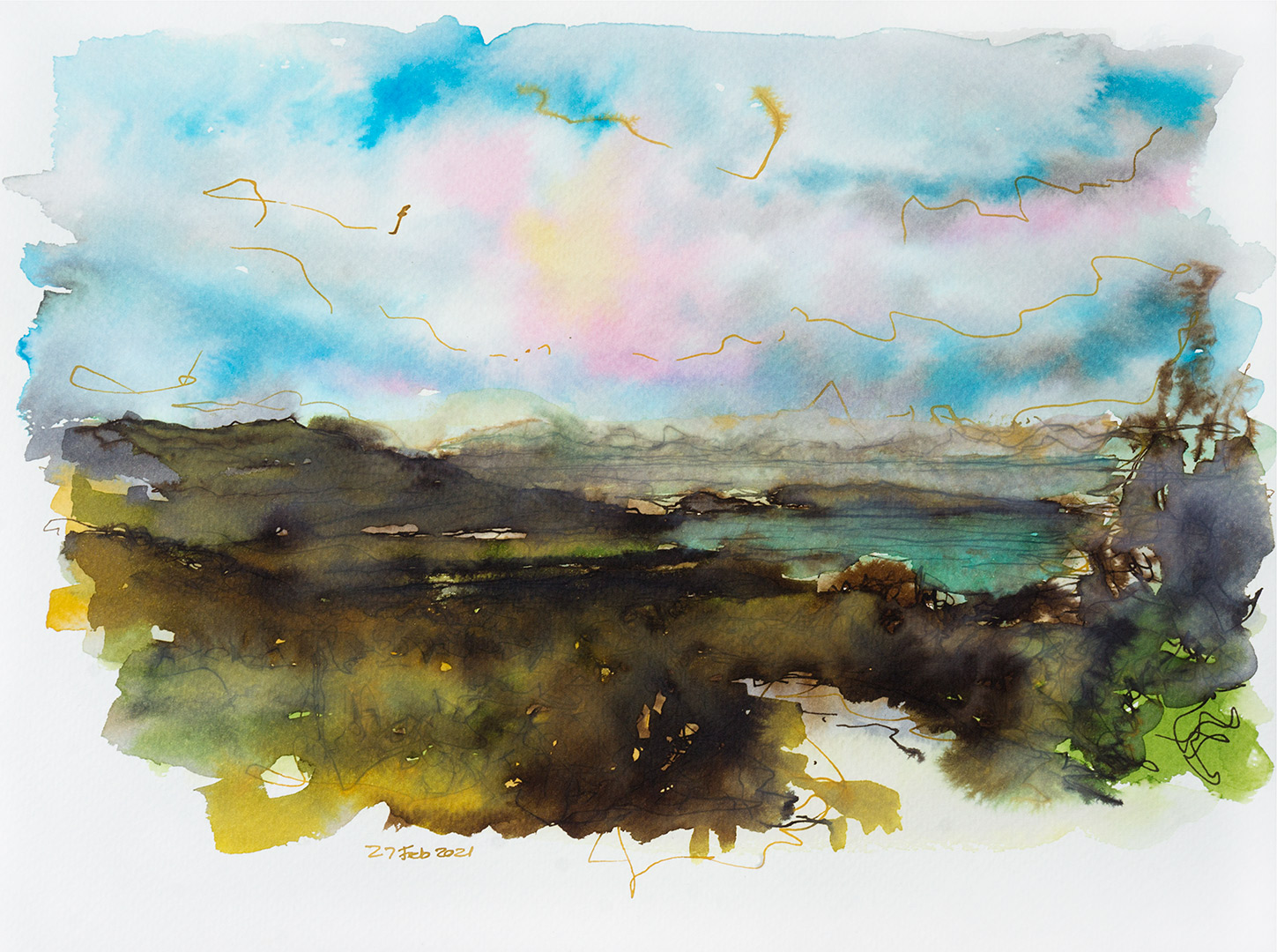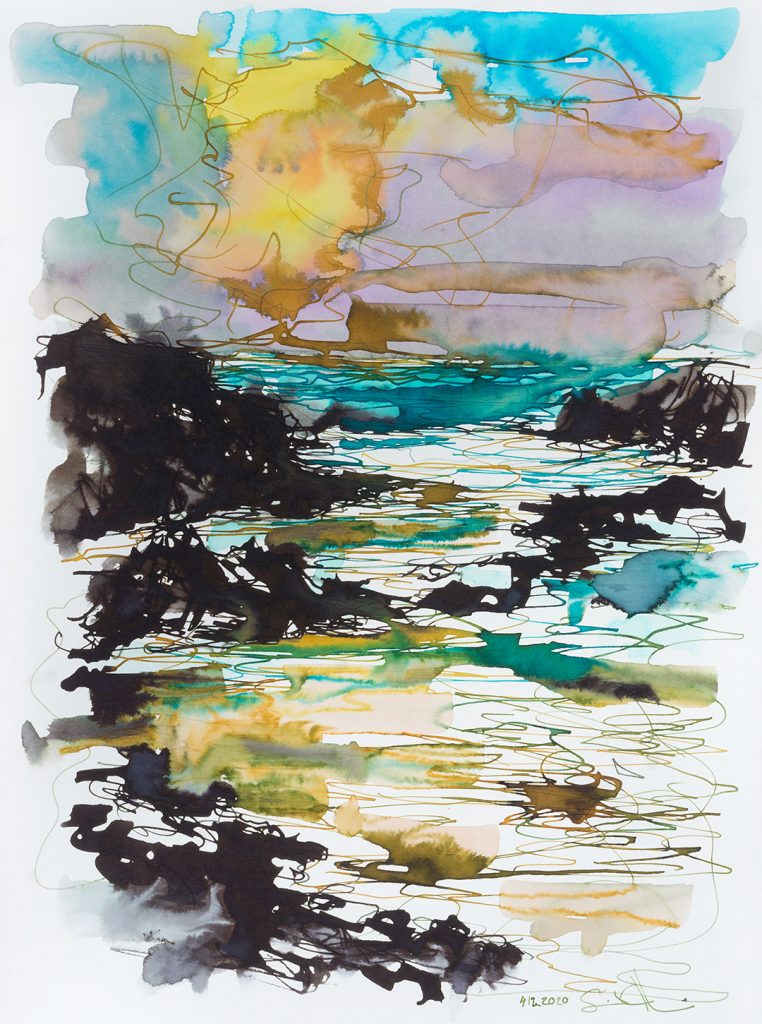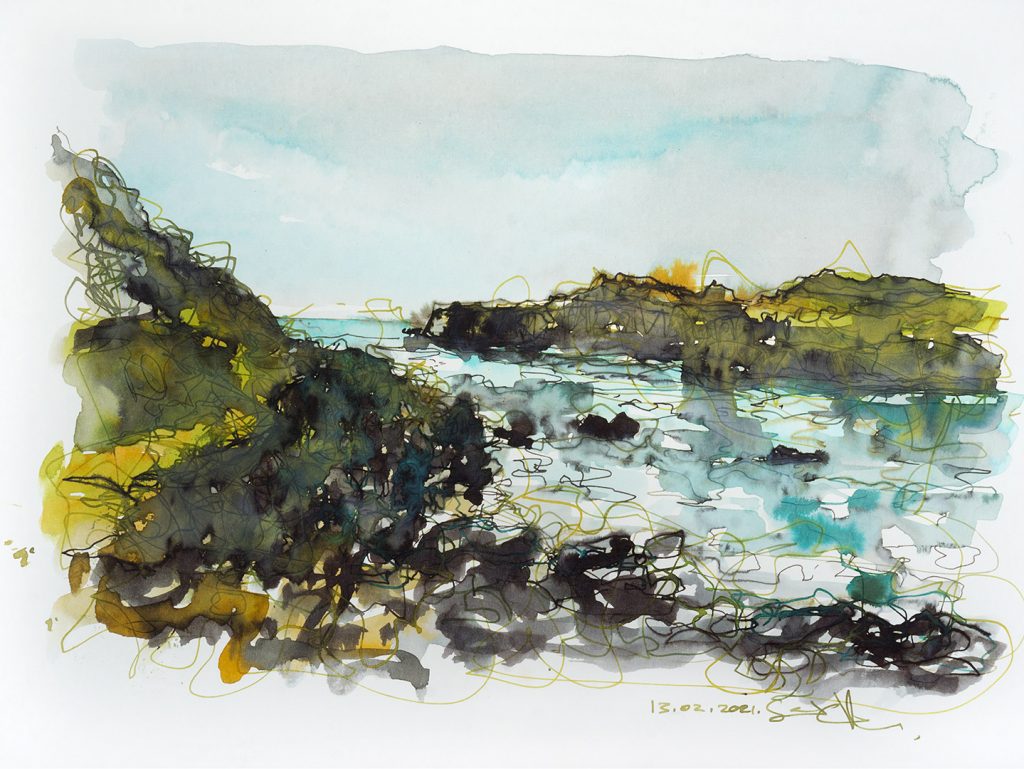Francis Bacon’s iconic studio, preserved in the Hugh Lane Gallery in Dublin, the paintings of Jackson Pollock, Vincent Van Gogh’s manic episodes and the idea of the eccentric or mad writer/professor all tell us that creativity is messy and chaotic. I don’t agree. Well not entirely….
Creativity can be chaotic. I have experienced the overwhelm of too many ideas, the sense of frustration of no ideas, the steep learning curves and the anxiety of not knowing what direction to move in, but I wouldn’t have stayed with it if I hadn’t also experienced the joy, ease and flow, the ecstasy of the heart, the mind opening moments of inspiration and the deep satisfaction of bringing a creative project to completion.
There are parts of the creative process that can be chaotic but there is an order to the creative process, I believe, that is as sublimely beautiful as systems in nature and the changing of the seasons, and like a wild landscape there is so much to be learned when we start to observe it.
One of the reasons creativity is so important to me is that from a young age it provided me with a compass and a map: the cycles of my own creativity gave me structure and holding to navigate challenges, the courage to make bold choices and a sense of purpose as I found my way.
The creative process is described in a multitude of ways: usually including waves of both ecstasy and torture. It can be described in stages of: preparation, incubation, illumination, and verification (Kaufman) or, creative invitation, preparation, inspiration, celebration and restoration (Kent). I don’t feel that the sequence of the process is all that important for what I’m talking about here but I do feel it is important to understand that creativity is cyclical in nature.
It is commonly believed that it is helpful to be firmly focused on a goal or outcome, but I don’t think this form of linear thinking is always helpful. I find its more important to stay grounded in the awareness that I’m creating within larger cycles of creativity.
Cyclical or iterative thinking relates to natural systems and their inherent feedback loops: allowing for layers of repetition and learning. Creativity does not happen in a linear way; it is a process of birth, growth, maturing, decaying, death and dying, composting and rebirth. It is a constantly moving evolving intelligent process.

The creative process as a natural cycle
All things in nature are part of moving cycles: the breath is part of the cycle of breathing in and out, we experience the sun as sunrise and sunset, the sea as changing tides, the weather and landscapes as part of changing seasons and the arc of time that is birth, life and death. Creativity comes through the body, as as dynamic and evolving process: we experience it through on-going changes in our body and senses, with their own rhythms and patterns.
If the creative process were described through seasons:
Winter is the time to take space for ideas, to gather information, it is a time of receiving: nourishing, reading, watching observing and taking in. There doesn’t seem to be much happening: there is little or no output. This is the place of quiet and stillness and of not ‘knowing’ in a conscious way, yet.
Spring starts with a spark of inspiration; fire; the eureka moment, then movement and growth begins. This is when we let ourselves respond to the information we have been gathering: freeing the ideas, words and movement. New connections are made; new ideas ignite. This stage is dynamic, propelled by inspiration, setting words on paper, hands drawing, painting, the body engaging those first key movements of the dance.
Summer is the place of letting the momentum carry us and just going with the flow. We surrender to it and let ourselves be carried. It is the time with the greatest intensity and output, when we’re deep in movement and flow with the feeling of being wide awake and alive. We get lost in the process and time seems to disappear. This stage is full of energy and like a spinning top there is time to spin and then naturally time to slow down.
Autumn is the natural trickling down and the satisfactory point when we have let the words and ideas express. We appreciate and celebrate and we begin to change gear again coming back to a more receptive, resting place of winter where we start the process again.
The shadow of the seasons
In an ideal scenario creativity would move smoothly through these stages, but this process is different for everyone. It can unfold quickly or may take a long time, we may repeat certain sections or spend much longer at some stages than others. And of course things don’t always go according to plan: obstacles will get in the way, you might not be prepared enough, external forces might change the outcome and you might have your own internal issues, fears, habits and addictions to deal with. Each of the ‘seasons’ has its shadow:
Winter is about resting and ease but it also a place where we can become rigid and stuck. We can stay in this stage feeling that we don’t have enough: information, tools, ideas or materials so we keep gathering and can end up feeling swamped and overwhelmed not knowing how to begin.
Spring is about the ignition and spark, but its shadow lies in the voice of the perfectionist and the inner critic: telling you that you’re not good enough and what you’ve done isn’t good enough. It is that sense of imposter syndrome; feeling like you’re just no good at what you do. It can stifle progress and cause some to give up.
Summer is about letting go into flow but instead of being in flow we can become distracted, disconnected, out of control and lost in this producing phase: lost in what others want of us, lost in fame or fortune or in quantity over quality. We can loose the thread of our own creativity and our own integrity. This stage can indeed be chaotic and out of control.
Autumn is about acknowledgement, celebration and changing gears but the shadow is where we are addicted to the ‘doing’ and resist coming back to simply ‘being’. We want the feeling of flow to continue we want more and we don’t recognise the need to stop, so we keep going beyond our capabilities, addicted and heading towards burnout.
Recognising that there is a cycle to the creativity can be interesting to read about but what does it mean for you and how can it help?
On-going process
The first thing I recommend is to begin to look at your creativity as a bigger process: letting yourself see each project, each creative endeavour as part of a greater creative cycle in your life. Understanding that creativity is an on-going cycle: no matter what you are doing, or not doing, you are in the process.
Observe
You can begin to recognise what stage of your creative process you are in and how you relate to it: observing how you create: what kind of experiences and actions inspire you, where your stumbling blocks are, where you spend more time, what stages drain you and what stages are easier. You can let the observation be a regular habit and learn from it. You might notice you have a tendency to spend too long gathering ideas and more time procrastinating: so you can experiment with limiting the number of ideas you gather and see how this stage can be different. If you have a tendency to keep on going when its really time to be slowing down, you can try setting yourself a deadline, slowing down a little and experimenting by letting yourself rest more.
Presence
Creativity is not a part of the brain and thoughts; it might appear that way but you will notice it first in your body, in your breath, it comes from your witness self. Let yourself come back to the present moment and just see, hear and feel: let yourself notice your own aliveness. Let your creative practice be a mindful one: allowing for moments of witnessing the sensations of your body, the contact you have with the earth, floor or chair and notice your breathing. Noticing if you are holding your breath or breathing in a shallow way. Taking a few mindful breaths. Noticing your thoughts like they are a skyscape: letting yourself witness them with curiosity.
Respect your body
Through pausing and listening, notice what your body is saying to you. If it is truly telling you to rest then this is what you must do. Taking regular breaks has been one of my big challenges: when I get into flow I just don’t know how to stop. I loose all track of time and can find myself sitting squinting in the dark at the end of a day where I have not eaten, drunk or taken a moment to rest all day. I could get away with it as a student and a young adult but as I get older I am learning the wisdom of kindness and rest. Take really good care of your body, nourish it, give it rest and it will respond to you with clarity and creative aliveness.
Orientate
Sometimes it takes me a while to realise that I am in a place of overwhelm, caught in a loop or eddy. What helps me get unstuck is to realise where I am in the map of my own creative process. Notice where you are and what you might need in that place. Recognise your options in any given place: the choice to sit and observe, take action, ask for feedback, walk away and digest, rest, seek inspiration, or let go of something that is not working.
You will learn that some blocks are a natural part of the process and some are psychological. By observing, listening and pausing notice what you might need, address your needs with compassion and learn to balance the need to truly rest, with the need to really call in more energy and move through your own blocks. It’s only through practice; trial and error, compassion and honesty that you learn to discern these differences for yourself.
The value of the seasons
Leaning in to the cyclical nature of my creativity has allowed me to explore different kinds of projects, to recognise similar creative threads and explore cross-pollinations between disciplines. It has also allowed me to ease my hold on specific ideas: I can now discern more when I am too attached to an idea.
We can’t control the process but we can listen and bring more awareness into the body: we can find more ease in the unknown and take care of ourselves. We can recognise when its time to take leaps of faith and that its alright let go of the need for success each time.
Some ideas will not work and will need to be tossed into the recycling bin, some ideas will be rotten and it will take us ages to recognise it. Leaning into the cycle allows me to trust in something greater than me: to trust the aliveness of the process and the aliveness in me when I accept where I am with it. It allows me to release my ego and my need to be best, the first, the fastest and instead to appreciate the aliveness of the process.
Creativity is not a static thing, it is a process and a practice that requires regular tending, and it is this on-going evolving relationship that opens us up to taking steps and leaps into the unknown. We can all benefit from encouraging and developing the uniqueness of our own creative process, whatever it might be, and without attachment to a final outcome or product. I am interested in how, when we engage creativity as a cyclical process, it allows us to open up and become more conscious of how we bring something completely new into being. Bringing with it more joy and a sense of fulfillment and purpose.
Let yourself observe and become curious, kind and familiar with your creative process. Much like a particular wild landscape in nature it might seem like any other, but when you take time and observe regularly you attune to its nuances: tiny movements and greater seasonal changes, learning to appreciate its uniqueness and the natural sacred order that underpins it.



